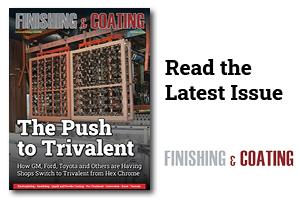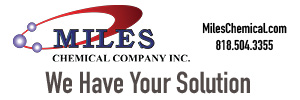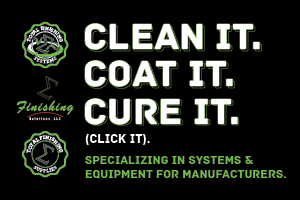If you are involved in manufacturing, if you are part of a supply chain, rugged critical cleaning processes will improve your productivity and profitability.
 Barb and Ed KanegsbergYou may be an OEM, a job shop, even a repair/rework facility. You may be the ultimate customer and have little or no direct contact with the manufacturing process. You may be both a customer and a supplier. Wherever you are in the supply chain, understand and take ownership of critical cleaning.
Barb and Ed KanegsbergYou may be an OEM, a job shop, even a repair/rework facility. You may be the ultimate customer and have little or no direct contact with the manufacturing process. You may be both a customer and a supplier. Wherever you are in the supply chain, understand and take ownership of critical cleaning.
Ineffective or incorrect cleaning is often the culprit in poor product performance. With supply chains, cleaning mistakes can become magnified. Take ownership of the cleaning processes – you will be rewarded by better business. Taking ownership involves understanding your part of the supply chain. This means developing a working, practical understanding of the steps it takes to build the product – especially the cleaning steps. If cleaning happens primarily at final assembly, soils can be difficult if not impossible to remove.
Critical Cleaning
Understanding the build steps includes identifying and controlling the critical cleaning processes. Critical cleaning is tipping point cleaning. Critical cleaning is removing soils in the correct manner, at the correct time (sooner rather than later), and at the correct point in the process.
Soil, or matter out of place, is inevitable in manufacturing. Cleaning is removing that soil. People often refer to precision cleaning; this either means final cleaning or cleaning parts that already look pretty clean. Precision cleaning can also mean cleaning parts in a controlled manner, doing the job the same way over and over again. The problem is that while you can clean in a very well-controlled, well documented manner, what if that cleaning process is wrong? What if it does not effectively remove the soil?
What if cleaning results in surface damage to the part? There can be too much cleaning. Too much cleaning or the wrong cleaning agents and processes can produce materials compatibility problems. The materials of construction or the surface finish can change, so that a cleaning process that has worked well in the past may produce surface damage.
Consider the importance of critical cleaning, whatever your part in the supply chain, be it a contract manufacturer, an OEM, a repair/rework facility, or an ultimate customer.
Specialized Job Shop/Contract Manufacturer
Job shops can be very specialized and sophisticated. Examples include metals fabrication, optics, electronics components production, electronics assembly, composites, plating, engineered coatings (like thermal spray and PVD), vapor deposition, biotechnology, and 3D printing. Unfortunately, some job shops think “building to spec” is sufficient; and they leave the cleaning to the final assembler.
If you are a contract manufacturer, don’t short-cut the cleaning process! Sometimes, a job shop may eliminate cleaning to save money or to avoid regulatory and permitting hassles. Shops may clean in an inconsistent, haphazard, and ineffective manner. Poor cleaning often results in a poor quality product. You may cut a few costs. However, cost is only one competitive factor; and most products or components can’t compete based on price alone.
At the same time, you have to comply with the regulations. Some job shops may struggle to cope with cumbersome, unrealistic, and often conflicting cleaning requirements set forth by distant, detached customers. They hide – wait in terror for an audit.
If you are a contract manufacturer or run a rework facility, it’s really important to establish internal procedures for critical cleaning. To do that, you have figure out what you customers want and need. Most important, define and document your own specifications. Internal company processes and guidance puts process control back in your hands. Setting up your own internal cleaning processes and specifications can be a great selling point that sets you above the competition.
OEM
As an OEM, you may be involved primarily the final stages of assembly, or nearly all of the manufacturing may occur under the “corporate umbrella.” At either extreme, it is important to look at the cleaning processes at each step of assembly. If you assume suppliers are building correctly because they build to spec, and if you are not concerned with the cleaning process, unforeseen, annoying, profit-reducing problems are a near certainty.
We see extremes with OEMs, and none of them work very well. Some OEMs switch suppliers constantly, buying primarily based on price. Buying on price alone means signing up for variability, poor quality, and lack of reliability. The OEM may wait and attempt to clean the parts in-house; they wonder why they see yield problems. Other OEMs may specify performance or basic appearance of the part without adding controls or specifications regarding the cleaning process – they basically tell their suppliers to provide parts that “meet the spec.” If you tell your job shops only to “meet the spec,” you may be providing a license to ignore process consistency and process monitoring. Still other OEMs may specify the cleaning processes in great detail in huge manuals. These manuals may be unrealistic. For example, we plough through manuals where one page makes a pronouncement about requiring a particular cleaning process; then maybe a dozen pages later, there is a second pronouncement prohibiting the use of that same process. Then imagine that the job shop has a dozen or so big clients, each one with confusing, contradictory, and unobtainable cleaning requirements.
Repair, Rework Facility
A repair and rework may deal with specific parts or components; or it can involve refurbishing the entire product. The customer may be an OEM or a job shop; examples include an aerospace corporation or an electronics assembler. It may involve a customer who is not involved in manufacturing. For example, some medical devices are refurbished and then sent to clinicians, hospitals, or patients. In all of these instances, we have to consider establishing, validating, and documenting cleaning processes specifically designed to the soils in question.
Repair and rework are not always thought of as critical cleaning processes. However, cleaning processes have to be very well thought out; and they have to account for variations in soils and in customer requirements.
Customer
Perhaps you manage a company that sells product that is essentially manufactured off-site. You think you do little or no assembly. Are you sure? Get out there on the manufacturing floor or over to the cleanroom and look around. Ok, so you checked; and you are convinced that little to no cleaning is happening; everything but final packaging is outsourced. Even in this unlikely event – especially in this unlikely event – to keep your business on top, you have to choose, specify and monitor all of your suppliers. The product you are selling was not manufactured or repaired by elves in a controlled environment. Understanding the features and pitfalls of cleaning processes conducted OEMs and job shops is essential to product reliability.
Linearity?
Surely you jest! It would be simple if we could consider the supply chain as a straight line. More often than not, supply chains are not linear; and they may be partially within a company (“captive job shops) and partially outside of the company. They often span the globe.
Many supply chains resemble cross-linked polymers, or proteins, or micelles. Ok, maybe you’re not a chemist or a biochemist; so do a web search on these words, check a few images. What you want to avoid is an uncontrolled supply chain. For a reasonable analogy to an uncontrolled supply chain, go to a garage sale; ask to see the jewelry. Chances are, you’ll see a tangled “blob” – that’s what you want to minimize in a supply chain.
There can be an inherent complexity to the supply chain. For example, for a particular product, a job shop may run process A, ship the part to a second job shop to do process B and then the original job shop may take the product back so you can do process C. Of course, the process being performed by that second job shop may involve outsourcing to a one or more additional job shops; and each of those job shops may have cleaning processes.
A three part solution
Supply chains are a given for today’s manufacturing. How can you resolve at least your part of this messy, confusing situation. We suggest a three part solution: mutual respect, transparency, and communication. Setting up and documenting critical cleaning processes in an atmosphere of this three part solution will go a long way to improving product consistency. If you are an OEM or a final customer, look for job shops and OEMs with defendable, well-documented, logical manufacturing processes. If you’re a job shop or a repair facility, make sure your critical cleaning processes make sense to you. We’ll discuss this three part solution more in future columns.
This article first appeared in the July 2015 issue of Clean Source.
Barbara and Ed Kanegsberg founded BFK Solutions in 1994 as a critical cleaning consulting service and the go-to resource to make cleaning, surface quality, and contamination problems go away, or — even better — to avoid problems in the first place. Barbara, widely known as “The Cleaning Lady,” is an expert and trusted adviser in critical cleaning. Ed is known as “The Rocket Scientist,” and they write Clean Source, an approximately monthly e-newsletter that provides practical ideas to improve cleaning, contamination control, and product quality. They are co-editors of and contributors to the acclaimed two-volume “Handbook for Critical Cleaning,” CRC/Taylor & Francis, 2011. Visit https://bfksolutions.com



































